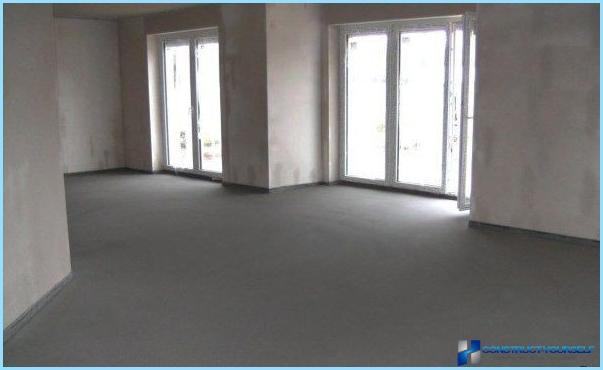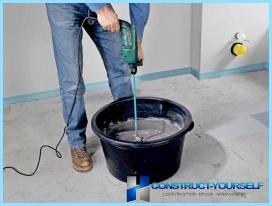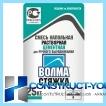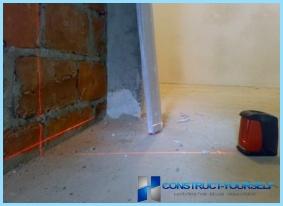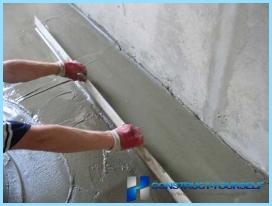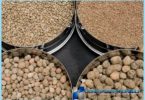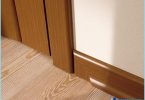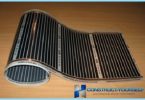The contents
- Sand-cement: composition, methods of execution
- Features semi TSPS with fiberglass
- The device of cement-sand screed
Cement-sand screed (TSPS) used for leveling stone and concrete floors and create a base under the finish floor. While it improves sound and thermal insulation properties of the base.
The use of this method of alignment is limited to a large proportion of TSPS. When the thickness of the screed 10 mm the weight of one square meter can reach 20 lbs. given the fact that the minimum thickness may not be less than 30 mm (this thickness allows to avoid cracking of the screed and its crumbling), and considering the weight of the insulation and the finishing coating, one square meter of floor will weigh about 70-75 lbs. Is the weight of a floor for the minimum allowable thickness of the TSPS. A layer thickness of 50 mm with the tile as a finishing coating will increase this value up to 130-140 kg. Therefore, cement-sand screed is used for leveling of floors in buildings where design of the supporting slab is designed for a payload of 300 to 400 kg/m?.
Heavy weight design of the CPS is, to a certain extent, its main drawback. Another disadvantage of cement-sand screed is a significant time required for complete drying. The DSP 40 mm thick dry for 7 days, but each additional 10 mm thickness requires an additional 15 days for drying each of them.
Sand-cement: composition, methods of implementation ↑
Composition of the DSP can be a conventional cement-sand mortar or be made from dry mixes. The composition of such ready mix varies for different types of ties.
Solution for TSPS mix from a mixture of cement (1 part) and sand (to 2.5-3 parts) with the addition of water (0.5 liters per 1 kg of cement). To this solution was added plasticizers, modifiers and fillers. The addition of these components in a cement-sandy solution eliminates the risk of cracking, increases the ductility of the screed and promotes rapid strength development in comparison with the solution involved with no additives.
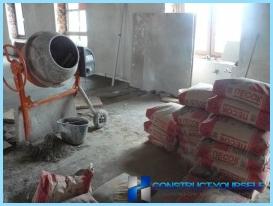
Construction to prepare the solution used in most of the finished dry mix. On the packaging of ready mix specified amount of water necessary for solution preparation, and consumption of the mixture per unit area in the thickness of the screed.
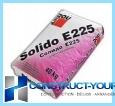
Requirements for the composition of the solutions are determined by GOST 28013-98 «Mortars».
There are the following methods of the device CPS:
- Wet. For the coupler used ready mix.
- Dry. The mixture is mixed on the jobsite.
- Dry. Used dry filling, followed by coating it with sheet materials.
The popularity of TSPS dry due to the possibility to significantly reduce the time of solidification of the surface. Usually this time is a few hours. The use of semi-dry screed minimizes the risk of subsequent cracking and avoids leakage of water from the solution through floors.
Features semi TSPS with fibro ↑
We have a relatively new method of the device of cement-sand screed. In the mixture to cement (in this case, a Portland cement) and fine quartz sand in addition to plasticizers and modifiers add fiber. The result is a reinforcement design using this component solution becomes unnecessary, and the traditional reinforcement mesh.
This technology (also called German) gives additional advantages:
- The cost of the device of cement-sand screed with fiberglass to lower the cost for the device ties and common reinforcement.
- The device is a screed takes much less time by reducing the drying time of the surface. This is achieved by reducing the amount of water used when mixing mortar. Screed ready for laying the topcoat after 4 days.
- The device DSP with fiberglass results in a completely smooth base surface. This is achieved using a power trowel machine that eliminates all micro-defects on the surface of the screed.
- Of impact resistance, such a screed is fully consistent with SNiP 22.03.13-88.
The device of cement-sand screed ↑
To obtain high-quality tie requires compliance with technology devices.
Surface preparation ↑
The surface under the device ties pre-cleaned thoroughly, cleaned the pieces, which exfoliates while rapping. Should pramesti prepare the surface and if possible clean it with vacuum cleaner. Technological holes in the base and holes are sealed with mortar and leveled.
Then, the surface is primed. The use of a primer will increase the adhesion between the screed and the Foundation. The primer eliminates the possibility of displacement of the lower layers of ties in the process. The primer is applied in two layers, the second layer should be applied after drying of the first.
Damping tape is placed around the perimeter of the premises after drying of the applied primer. The tape serves to seal premises and to protect the tie.
Marking the level of the screed ↑
The layout faster and easier to do with a laser level. Don’t forget that the thick sand-cement screed can not be less than 30 mm, otherwise the screed will crumble and crack. The thickness of the screed in a particular room is determined by the project or, in his absence, by the need to solve specific problems (to hide communication, to level out the grounds with a large bias, etc.). The laser level is mounted on a base in the center of the room and on the walls made the mark at the desired height. The point where you set the laser level should have a maximum height in the room.
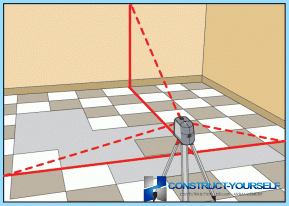
Beacons ↑
Beacons are called rails, on which the alignment surface of the screed. Accordingly, the correct placing of beacons depends on the quality of the device of cement-sand screed.
For the device couplers use a ready-made metal or mortar beacons. Ready to use metal beacons, greatly simplifies the process.
The beacons are arranged strictly parallel to the surface. Width between beacons depending on the length of the rule and must be 200 mm shorter. If the rule length is 2000 mm, the beacons are arranged at a distance of 1800 mm from each other.
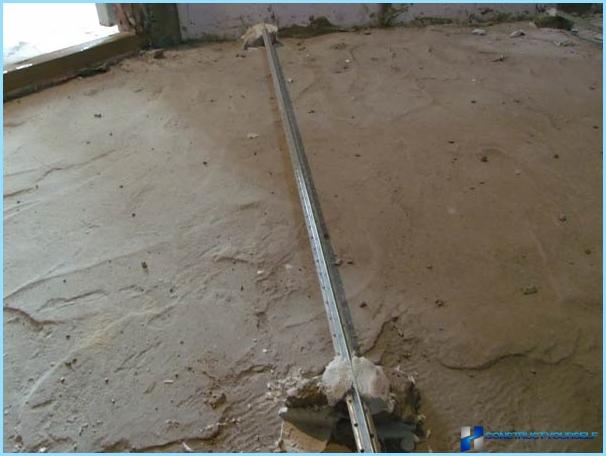
After marking the level of the beacons rise to the required height and fixed with a solution from which to get screed, plaster or stucco. Important! Beacons should not have camber throughout their length. In places of bends are installed gasket that they were at the correct height, and beacons are fixed.
The mixing of the solution and the device ties ↑
After drying the solution with beacons, the surface is moistened with water. Conventional cement-sand mortar is mixed on the basis of a ratio of 1 part cement to 3 parts sand with the addition of water at the rate of 0.5 liters per 1 kg of cement. The solution is mixed using a mixer or nozzle on the drill.
A solution of dry mixtures is mixed according to the instructions on the package. Plasticizers and modifiers are also added according to the instructions.
Mortar attacks (poured) on the surface and in the sky rule.
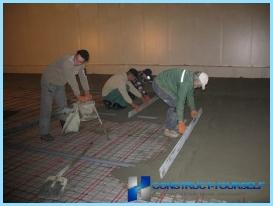
Leveling screed can hold a trowel by machine or by hand. In the second case, prepared a mixture for the grout (1 part cement to 1 part sand). The result is a smooth, slightly rough surface of cement-sand screed.
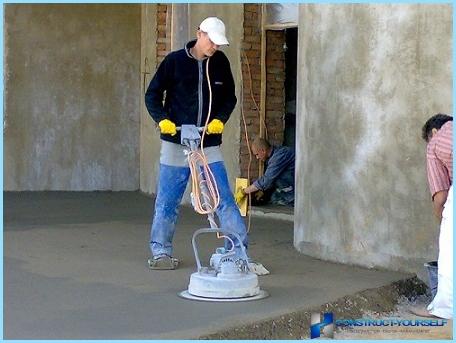
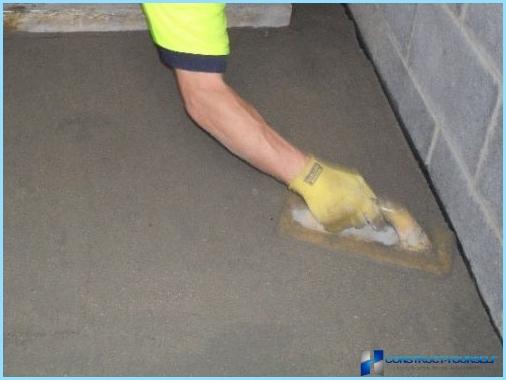
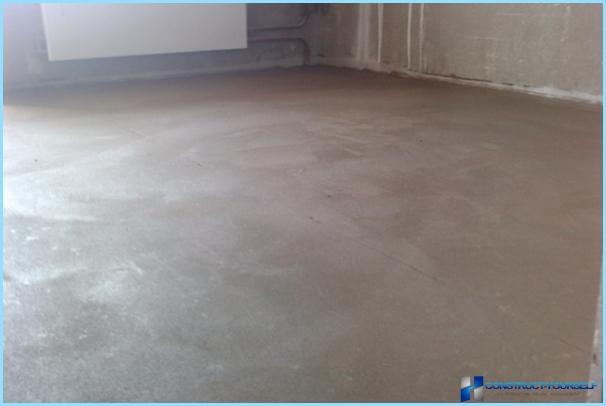
After completion of screed the surface should be wetted with a wet roller, and close the day with plastic wrap. Through the day repeat the procedure. The drying time of cement-sand screed is determined from the thickness of the layer: 7 days for complete drying of the layer thickness of 40 mm, plus 15 additional days for drying each of the next 10 mm of the screed layer.
The addition of a solution of modifiers and plasticizers will significantly shorten the time between completion of screed and starting work on finishing the floor in the room. In addition, the screed will not crack.
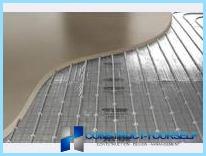
The cost of cement-sand screed ↑
The cost of the device CPS consists of the cost of the materials used and the cost of the work. In Moscow the cost of one square meter of the DSP starts from 400-430 rubles. However, we are talking about large volumes.
Ready dry mixes are usually Packed in Kraft bags with a weight of 25-50 kg. Manufacturers claim that the consumption of the mixture is about 20 kg per 1 m? screed with a thickness of 10 mm. the price of the bag varies depending on the composition of the mixture. Prices start from 130 rubles/bag (sand concrete).

